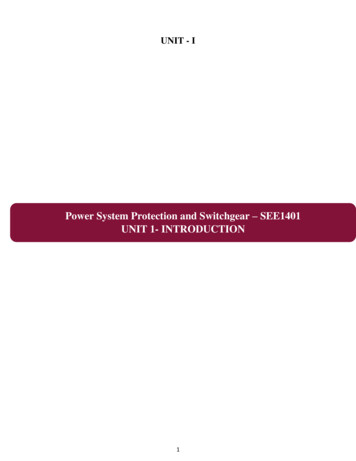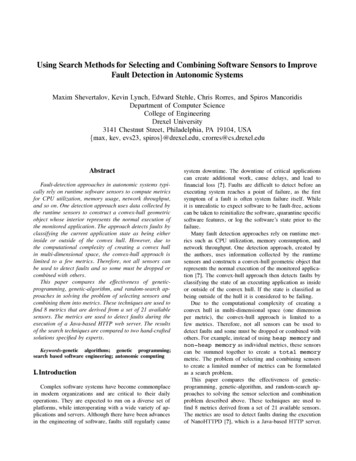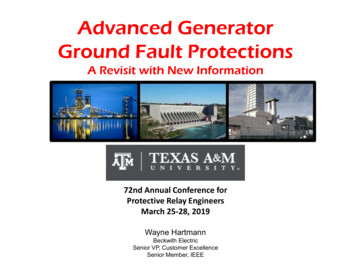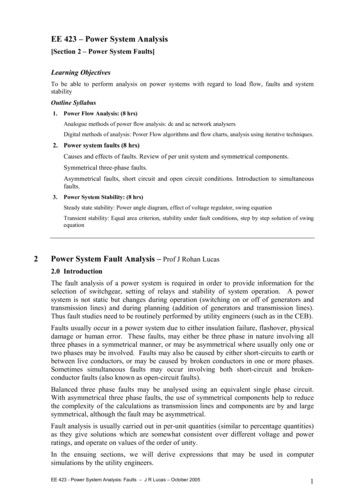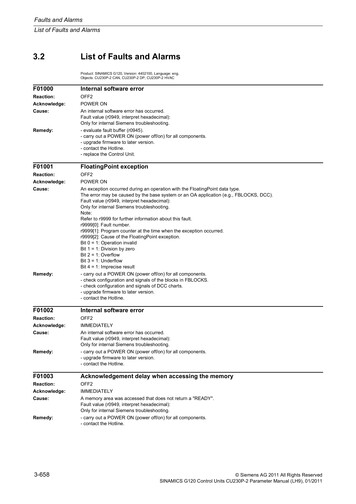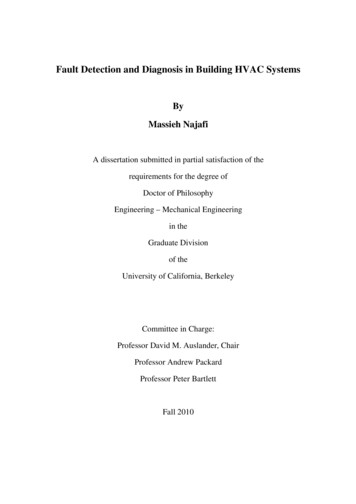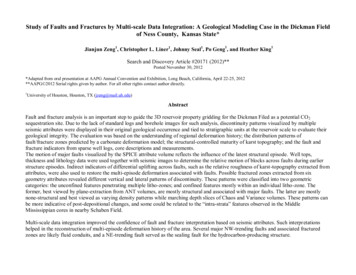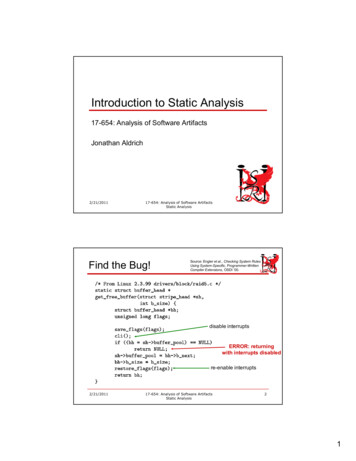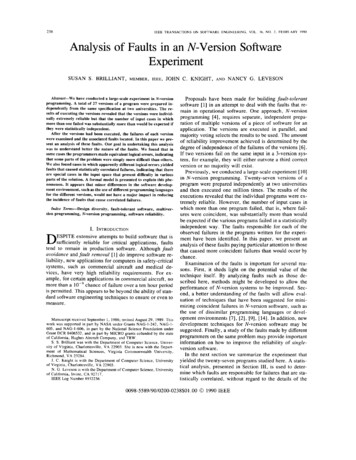
Transcription
238IEEE TRANSACTIONS ON SOFTWARE ENGINEERING. VOL. 16. NO. 2, FEBRUARY 1990Analysis of Faults in an N-Version SoftwareExperimentSUSAN S . BRILLIANT,MEMBER, IEEE,JOHN C. KNIGHT,Abstract-We have conducted a large-scale experiment in N-versionprogramming. A total of 27 versions of a program were prepared independently from the same specification at two universities. The results of executing the versions revealed that the versions were individually extremely reliable but that the number of input cases in whichmore than one failed was substantially more than would be expected ifthey were statistically independent.After the versions had been executed, the failures of each versionwere examined and the associated faults located. In this paper we present an analysis of these faults. Our goal in undertaking this analysiswas to understand better the nature of the faults. We found that insome cases the programmers made equivalent logical errors, indicatingthat some parts of the problem were simply more difficult than others.We also found cases in which apparently different logical errors yieldedfaults that caused statistically correlated failures, indicating that therea r e special cases in the input space that present difficulty in variousparts of the solution. A formal model is presented to explain this phenomenon. It appears that minor differences in the software development environment, such as the use of different programming languagesfor the different versions, would not have a major impact in reducingthe incidence of faults that cause correlated failures.Index Terms-Design diversity, fault-tolerant software, multiversion programming, N-version programming, software reliability.I. INTRODUCTIONESPITE extensive attempts to build software that issufficiently reliable for critical applications, faultstend to remain in production software. Although faultavoidance and fault removal [ l ] do improve software reliability, new applications for computers in safety-criticalsystems, such as commercial aircraft and medical devices, have very high reliability requirements. For example, for certain applications in commercial aircraft, nomore than achance of failure over a ten hour periodis permitted. This appears to be beyond the ability of standard software engineering techniques to ensure or even tomeasure.DManuscript received September 1, 1986; revised August 29, 1989. Thiswork was supported in part by NASA under Grants NAG-1.242, NAG-1605, and NAG-1-606, in part by the National Science Foundation underGrant DCR 8406532, and in part by MICRO grants cofunded by the stateof California, Hughes Aircraft Company, and TRW.S . S . Brilliant was with the Department of Computer Science, University of Virginia, Charlottesville, VA 22903. She is now with the Department of Mathematical Sciences, Virginia Commonwealth University,Richmond, VA 23284.J . C. Knight is with the Department of Computer Science, Universityof Virginia, Charlottesville, VA 22903.N. G. Leveson is with the Department of Computer Science, Universityof California, Irvine, CA 92717.IEEE Log Number 8932236.ANDNANCY G. LEVESONProposals have been made for building fault-tolerantsoftware [ l ] in an attempt to deal with the faults that remain in operational software. One approach, N-versionprogramming [4], requires separate, independent preparation of multiple versions of a piece of software for anapplication. The versions are executed in parallel, andmajority voting selects the results to be used. The amountof reliability improvement achieved is determined by thedegree of independence of the failures of the versions [6].If two versions fail on the same input in a 3-version system, for example, they will either outvote a third correctversion or no majority will exist.Previously, we conducted a large-scale experiment [ 101in N-version programming. Twenty-seven versions of aprogram were prepared independently at two universitiesand then executed one million times. The results of theexecutions revealed that the individual programs were extremely reliable. However, the number of input cases inwhich more than one program failed, that is, where failures were coincident, was substantially more than wouldbe expected if the various programs failed in a statisticallyindependent way. The faults responsible for each of theobserved failures in the programs written for the experiment have been identified. In this paper, we present ananalysis of these faults paying particular attention to thosethat caused more coincident failures than would occur bychance.Examination of the faults is important for several reasons. First, it sheds light on the potential value of thetechnique itself. By analyzing faults such as those described here, methods might be developed to allow theperformance of N-version systems to be improved. Second, a better understanding of the faults will allow evaluation of techniques that have been suggested for minimizing coincident failures in N-version software, such asthe use of dissimilar programming languages or development environments [7], [2], [9], [ 141. In addition, newdevelopment techniques for N-version software may besuggested. Finally, a study of the faults made by differentprogrammers on the same problem may provide importantinformation on how to improve the reliability of singleversion software.In the next section we summarize the experiment thatyielded the twenty-seven programs studied here. A statistical analysis, presented in Section 111, is used to determine which faults are responsible for failures that are statistically correlated, without regard to the details of the0098-5589/90/0200-0238 01.OOO 1990 IEEE
239BRILLIANT et ul. : N-VERSION SOFTWARE EXPERIMENTfaults. The faults themselves are summarized in SectionIV, and the interrelationships between the faults are discussed in Section V. It was found that faults that producestatistically correlated failures are not necessarily semantically similar, and vice versa. Thus, faults that atfirst sight seem unrelated sometimes cause coincident failures, and faults that seem very similar sometimes do notcause coincident failures. A formal model to explain thisphenomenon is presented. Our conclusions are presentedin Section VI.11. EXPERIMENTSUMMARYOnly the major features of the previous experiment aredescribed in this paper since the details have been published elsewhere [lo]. The application used in the experiment was a simple (but realistic) antimissile system thatcame originally from an aerospace company [ 151, [5]. Theprogram reads data representing radar reflections. Usinga collection of conditions, it decides whether the reflections come from an object that is a threat and, if so, asignal to launch an interceptor is generated.Twenty-seven students in graduate and senior levelclasses in computer science at the University of Virginia(UVA) and the University of California, Irvine (UCI)wrote programs from a single requirements specification.The programs were all written in Pascal, and developedon a Prime 750 system using the Primos operating systemand Hull V Pascal compiler at UVA and on a DEC VAX11/750 running 4.1 BSD Unix at UCI.An attempt was made to obtain programmers with varied experience but this was necessarily limited by the needto use students as subjects. Fifteen of the programmerswere working on bachelor’s degrees and had no prior degree, eight were working on master’s degrees, and fourwere working on doctoral degrees. The graduate studentsincluded four with degrees in mathematics, three with degrees in computer science, and one each with degrees inastronomy, biology, environmental science, managementscience, and physics. The programmers’ previous workexperience in the computer field ranged from none to morethan ten years. There appeared to be no correlation between the programmers’ experience levels and the qualityof their programs.Once a program was completed and tested by the programmer, it was subjected to an acceptance procedure thatconsisted of two hundred randomly-generated input cases.A different set of two hundred inputs was generated foreach program in order to avoid a general “filtering” ofcommon faults by the use of a common acceptance procedure. The acceptance procedure was not part of the process of testing the programs. It was a quality filter usedto ensure that only programs capable of a minimum levelof performance were used in the analysis.Accepted programs were subjected to one million randomly-generated input cases in order to observe operational behavior. The determination of the success of thetwenty-seven individual versions was made by comparingtheir output with a separate version, referred to as the goldprogram, that had been subjected to extensive previousanalysis.As required by the specification, each program produces a 15 by 15 boolean array, a 15 element booleanvector, and a single boolean launch decision (a total of241 outputs) on each input case. Afuilure was recordedfor a particular version on a particular input case if therewas any discrepancy between the 241 results produced bythat version and those produced by the gold program, orthe version causes some form of fatal exception to beraised during execution of that input case.We define a fault formally in Section V and use it toexplain the results of the work described in this paper. Wedefine a fault here, informally, to be a defect in the algorithm implemented by a program version that is responsible for at least one failure in the sense that changingthe program so as to correct the defect would allow theprogram to obtain output agreeing with that of the goldprogram for that input case. For each of the twenty-sevenversions, the faults were identified by examining the output of the program for input cases in which failure occurred and analyzing the source text.Once a fault was located, a correction was devised. Theversion containing the fault was modified so that eitherthe original faulty code or the corrected code could beexecuted. The purpose of modifying each version in thismanner was to allow the identification of the fault or setof faults responsible for each failure recorded for the version. Each input case that caused the version to fail originally was regenerated. The version was then executedwith each individual fault corrected in turn.For most failures, a version worked correctly when oneand only one of its faults was corrected. For these cases,the fault corrected on the execution that gave correct results was assigned sole responsibility for the failure. In afew instances, correcting either of two faults gave correctresults, so it was recorded that the failure was attributableto either of the two faults. In some cases none of the executions with a single fault corrected yielded correct results. For these failures the version was executed witheach pair of faults corrected in turn, then with each set ofthree faults corrected in turn, and so on, until correct results were obtained. The faults corrected on the executiongiving correct results were assigned collective responsibility for the failure.111. STATISTICALANALYSISOFTHEFAILURESFor the purposes of discussion in the remainder of thispaper, the individual faults are identified by the versionnumber in which the fault occurs concatenated with a sequence number for the faults associated with that version.Thus, for example, fault 3.1 is the first fault associatedwith version 3. The faults found in each of the twentyseven program versions and the number of failures attributable to each fault are shown in Table I. Failures associated with more than one fault are counted in the numberof failures for each of the associated faults.
240IEEE TRANSACTIONS ON SOFTWARE ENGINEERING, VOL. 16. NO. 2. FEBRUARY I Y Y OTABLE IFAULT:auhNumber of 12.112.213.114.114.216.116.217.117.2-FaullNumber of 73572826014803140916436824 3-The manifestations of a few of the faults were implementation-dependent. When the fault-to-failure identification analysis was performed, a version sometimes executed correctly for an input case on which it had failedoriginally. This effect was caused by differences in thehardware and compilers used, and it was observed for versions 6, 22, 23, and 26. Analysis of the input cases involved allowed the original failures of versions 6 and 23to be attributed to faults 6.1 and 23.1 respectively, sothese failures were included in the failure counts for theassociated faults in Table I. For versions 22 and 26, theoriginal failures could not be associated with specificfaults. These original failures are not included in any ofthe failure counts shown in Table I.In order to determine which faults caused statisticallycorrelated failures, a statistical test of independence wasperformed between each pair of faults where the two elements in a pair come from different versions. A matrix Cof the coincident failures caused by each pair was constructed. Coincident failure here means that both versionsfailed and includes failures with both identical and nonidentical outputs. This matrix is indexed in both dimensions by the sequence of fault numbers. Thus, C,j represents the number of test cases in which the two programversions containing faults i and j both failed because offaults i and j . Clearly C is symmetric, and its diagonalrepresents the failure rates for the individual faults.For each pair of faults, an approximate x 2 test [8] wasused to test the null hypothesis that the corresponding twofaults cause failure independently. The observed value ofthe x statistic for each pair i, j of faults causing commonfailures was calculated, using the following expression forthe test statistic:n w , - CIlC//YC;;c,(n - C;;)(n- C;;)wheren total number of input cases 1,000,000.Where the observed x2 statistic is greater than 7.88, thenull hypothesis of independence can be rejected with 99.5percent certainty. The results of the 945 separate hypothesis tests are shown in Table 11. An “R” in Table I1 indicates that the null hypothesis was rejected for the corresponding pair of faults at the 99.5 percent level. In thatcase, we define the two faults to be failure correlated.The statistical test used here is valid only if the value ofC, is “sufficiently large,” and values greater than or equalto five are generally considered to give satisfactory results. A “?” entry in Table I1 denotes a case in which thevalue of the x 2 statistic was large enough to justify rejection of the null hypothesis, but for which the value of C,is too small to justify reliance on the hypothesis test.Dashes in the table denote entries for which the statistichas no relevance because the faults are in the same program.The results of these hypothesis tests indicate that 93 ofthe hypotheses should be rejected; that is, 93 fault pairsfound in the experiment are responsible for statisticallycorrelated failures. An additional 67 pairs appear correlated but there is insufficient data to have confidence inthis conclusion. The use of a confidence level of 99.5 percent means that the probability that the null hypothesiswill be rejected when in fact it is true is 0.5 percent. Thus,if the null hypothesis is in fact true for each of the 945hypothesis tests that were performed, the expected number of erroneous rejections is approximately five whereas93 were rejected.It is clear from the preliminary data that more coincident failures occurred than would be expected by chance[IO]. The results ofthese statistical tests show which faultswere responsible for the coincident failures. In the rest ofthis paper, we examine these faults more carefully.I v . DESCRIPTIONSOF THE FAULTSThe faults in the programs were examined to determinewhether those that are failure-correlated have any uniquecharacteristics. Table I11 contains the details of the individual faults including the part of the problem involved(LIC number), the type of input that triggers the fault, anda short description of the fault.Several of the faults involve mistakes in the use of limited-precision arithmetic and require some further explanation. The source text of a function called REALCOMPARE, containing only four executable statements, wassupplied to the programmers. They were instructed to useREALCOMPARE for all comparisons of real numbers.This function defines the relational operators for floatingpoint numbers in the manner described by Knuth [ 131. AsKnuth points out, operators should be defined for floatingpoint comparison that allow many of the normal axiomsof arithmetic to be assumed.The REALCOMPARE function performs limited-precision floating-point comparison. It does so by comparingits two floating-point arguments, returning EQ when thedifference between the two values is less than 0.000005of the larger value. Otherwise the function returns LT
BRILLIANTel24 Ial.: N-VERSION SOFTWARE EXPERIMENTTABLE I1RESULTSOF .125.225.326.126.226.326.426.526.626.7-- . . . . . . . . . . . . . . . . . . . . . . . .RR . .R . . . . . . .? . . .R.R.RR. RR R . .R R? R ? . R R. . . ?RR . .R.?.R? . . . . . . R ? . R R . . . . . . ? R. . . . . . . . . . . . . . . . . . . . . . . . . . . . . . . . . . . . . . . .- . . . . . . . . . . . . . . . . R R ? . . . . . . . . . ? . . . . . . . . . ? . . . . . - - . . . . . ? . . . . . ? . . . . . . ? . . . . . . . . . . . . . . . . . . . . . - . . . R . . . . . . . . . . . . . . . . . . . . . . . . . . . . . . . . .? . . . . . . . . . . . . . . . . . . . . . . . . . . . . . . . . . . . . . . . . . ?. . . . . . . . . . . . . . . . . . . . . . . . . . . . . . . . . . . . R R . . . . . ? - - . .R . ? . . ? . . R ? . ? R R . . R . . R. . .R. RR. R RR RR . . . R . . . R ? . . R R . . R . . . . . R R . . . . . . . . . . . R. . . . . . . . . . . . . . . . . . . . . . . . . . . . . . . . . . . . . . . . . . . .? . . . . . . . . . . . . . . . R R . . ? . . ? R R . . - . ? . R ? R . R ? . . R R . . R . . R . . ? R . . . . . .R R. R R . . ? . . ? R R . . R . ? . R ? R . R ? . . - - . . R R R R . . ? R . . . . . .R R. . . . . . . . . . . . . . . . . . . . . . . . . . . . . . . . . . . . . . . . . . . . ? . . . . . R ? . . . ? - - . . . . . . . . . . . . . . . . . . . . . . . . . . . .? . . . . . . . ? . . . . . . . . . . . . . . . .R . . . . . . .R.R.--.RR.R.?.R. . ? . . . . . R?. . . . . . . . . . . . . . . ? . . . . . . .? ?. . . . . . . . . . . . . . . . . .R . . . . . . . . . . . . . . . . R ? . R . . . .R R . .R . . . . . . .? ? R R . . R . . ? ? . ? R . . . . . . R .? R R . R . . . ? ? ? . . ? . ? . . ? . R ? . . . . . ? ? . . ? . . . . . I ?. . ? . ? . . . . . . . . . . . . . . . . ? ? - . . . . . . . . . R. . . . . . . . . ? . . . . . . . . . . .?. R R . . . . . ? R R . . R . ? . R ? . .R R . ? - - . . R . . R . . R R . . . . . . R R. . . . . . . . . . . . . . . . . . . . . . . . . . . . . . . . . . . . . . . . . . . . . . . . . ? . . . R . . . . . . . . . . . . . . . . . . . . . . R . . . . . . . R R . ? R . . . . . R . R . . . R R? . R ? R . . . . . .R R. . . . . . . . . .R. R R . . . . . . R . . . R . . . . . . . ? ? . . R R . . ? . . - - . . R . . . . . .? R. . ? . ? . . . . . . . . . . . . . . . . ? ? R . . . . . . . . . . . . . . . . . . . . . . . . . . . . . . . . . . . . . . . . . . . . . . .R? ?. . . . . . .R.?.R.?.R?.?.--. . . . . ? ?. R R . . . . . ? R R . . R . ? . . ? . . R ? . . R R . . R . . R . . - - - . . . . .R R. . . . . . . . . . . . . . . . . . . . . . . . . . . . . . . . . . . . . . . . .-. . . . . . . . . . . . . . . . . ? . R R. . . . . . .?. . . . . . . . .? . . . . . . . . . . . . . . . . . . . .- - - - ---- - - - - - . . . . . . . . . . . . . . . . . . . . . . . . . . . . . . . . . . . . . .- - - - - - . . . . . . . . . . . . . . . . . . . . . . . . . . . . . . . . . . . . . .- - - - - - . . . . . . . . . . . . . . . . . . . . . . . . . . . . . . . . . . . . . . R ? . ? . . . . R R . . R . . . . . ? . R ? . . R R . . R . . ? . ? ? R . - - - - - - . .R . . . . . .RR . .R.R.?.?.?RR.R.R.?R.-------(GT) if the first argument is less than (greater than) thesecond. Essentially what REALCOMPARE does is to establish a region around the larger operand in which theoperands are considered equal. The size of the region isdetermined by the size of the larger operand.Four of the programmers erroneously used limited-precision comparisons with zero to determine sign, i.e., theyattempted to use REALCOMPARE to determine if anumber was negative. It is clear that small negative numbers (i.e., close to zero) will be interpreted mistakenly asnonnegative using this approach to determining sign. Thistype of fault could have been a result of inexperience onthe part of the programmers although one of the participants making this mistake had many years of work experience in real-time, scientific programming. None ofthese faults were failure-correlated with each other and sodo not contribute to our analysis of coincident failures.Several faults arose from the comparison of the cosinesor sines of angles rather than the angles themselves. Al-though mathematically the comparisons are equivalent,difficulties arise due to the relatively flat shape of the cosine and sine curves near zero and one, respectively. Onthe flat parts of these curves, angles that are quite differenthave cosines or sines that are nearly equal, so comparisons using a tolerance find that the angles are different,but their cosines or sines are equal within the tolerance.The specification for the application stated that angleswere to be compared, not functions of angles.An opportunity for multiple correct solutions also arosefrom our attempt to encourage diversity. Launch conditions 3 and 10 require the determination of whether theangle formed by three points satisfies either of the conditions:angle (T - E )orangle (T E)
242IEEE TRANSACTIONS ON SOFTWARE ENGINEERING, VOL. 16. NO. 2 . FEBRUARY 1990TABLE I11FAULTDETAILSFAULTLIC#IINPUT CONDITIONIFAULT DESCRIPTION1.1LIC3. I OIAnelesnearn e.Elarae.ICalcuhles anaks between A and k ralher thanbetween o &-A.( F IteauseSt o l m c e for comparisOn with A E much gIeab3 lhan fW A E.) 3.1subtended angle- misses case in which angle is zem.Similar to fault 3.1.angle zero).3.2angle zero).3.3(WO Mher points. calculeces distance to nearest point(rather than m u ) when mints are collinear and firstangle zero).3.4LIC 3 . 1 0Three almost collinear points.6.1LIC 9. 14A set of three points in which eachpair has a common coordinate.Inaccurate algorithm to m i n e cdlinearity; pointshead as collinear when iust nearlv collinear.In determining coincidence. “and“ and “or” conI d in predicate (results in points described in inputcondition being mated as if two of Ihe points win-6.26.37.18.1angle zero).8.29.1ILIC 2,9,149.2LIC 4.11,1511.1LIC 3, IO12.112.2.angle zero).Three points form acute triangle forwhich- length of longest sideexceeds perpendicular distance tothird vertex.Three collinear or almost collinearpoints.I izonlal and verlical linespoints f&LIC 5IIILIC 3, IOI k e almostecollinear points (an-IIILIC 2.9.1414.1LIC IO14.2LIC 3. IO16.1LIC 3.1016.217.1LIC 2.9.14LIC 317.2LIC IO18.1LIC 3. IO19.1LIC 3.10Vertex coincides with an endpoint.20.1LIC 3, IO20.2LIC 3, IO21.1LIC 3, IOThree collinear points (subtendedangle zero).Three collinear or almost collinearpoints (subtended angle near zero).Coincidentpoints.21.222.1LIC 2,9,14LIC4Machine round-oN m r c a w calculated cosine ofanele famed bv three minu to be mater than 1.Predicate wine instead of results in incorrectassignmentto t.Similar to fault 7.1.ComperisMl with zem using REALCOMPARE usedto ensure that a quantity to be used as an argument Dsqr isnonnegdtive.C o m p l i relationship amongthree points arising From algorithmused OI wmprte radius of circlecontaining the points.Two ofthree points foincide.13.1an obtuse triangle.Due to machine mundoff error. negative result obtained when length of one side of triangle subtractedfmm half ia nerimeterThree collinear or almost collinearmints (subtended anele near zero).Point 1rieht si& of x-axis.d e war7eml.I Inconecl pah condition to detemine whaher threeII.Apparent typographical error in array index handlingspecial c a x of second point coincident with eitherfiRI M22.2LIC 1122.3LIC 1523.1LIC 3, IO23.224.1LIC 3, IOLIC 2,9,14IIlluee almost collinear points (subtended angle near zem).‘Iluee collinear points (subtendedangle is x).Seefault13.1.Three almost collinear points (subtended angle near zero).Three almost collinear wints (subtended angle near zero).Angles near E E. E large.Similar to fault 7. I .Angle measurement of 180 rather than E used whenpoint 2 between points I and 3.Similar in origin and effect to fault 13.1.Cosines rather than angles compared.See fault 13.1.Three collinear or almost collinearpoints.Three collinear or almost collinearpoints.Three collinear or almost collinearmink .Three collinear or almost collinearpoints (subtendedangle near zero).Angle near x E. E large.Coincident points.third.Similar 10 fault 17.1.ISimilar to fault 1.1--occurs on a different set of angles.Decides condition not satisfied by any set of threepoints when one set involves a coincident vertex andendmint.If tangent is zero. assumes angle is E; misses case inwhich angle is zero.In applying formula tan sqn(l-sqr(cos))/cos, roundoff error causes negative argument U) sqrl.Special case for coincident points in algorithm forcomputing smallest circle containing three pointsfails when first and second points coincide.Similar in origin and effect to fault 13.1.Similar to fault 9.2.Similar to fault 9.2.Similar to fault 9.2.Uses REALCOMPAREto delermine if calculatedangle negative; misses some angles near zero.Similar to fault 18.1.Error in arguments to function that determines coincidence (coincidence of points 1 and 2 checked rathertban that of 1 and 3).
BRILLIANTEI al. :243N-VERSION SOFTWARE EXPERIMENTTABLE I11 (Continued.)FAULTI25.1I25.2LIC#LIC 3. IOI INPUT CONDITIONI1 Thrcc collinear poinu (subtcndcd Ianglc zero).LIC 3, IOThroe collincar poinu (subsndedFAULT DESCRIPTIONMissing casc in computing anglc formed by threepoints whcn point 1 lies bctwccn points 2 and 3 nndis closcr IOpoint 2 than LO point 3.Similar 025.l.diffcrcntpsth.anQkZCIO).tcation to identify which of the two possible angles is tobe measured would reduce the choices available to theprogrammer, thus reducing the potential diversity amongthe versions.V. DISCUSSIONL’(b)Fig. 1. The angle formed by three points.where E is a parameter supplied as input. The specificationindicates that the second of the three points is the vertex.However, as is illustrated in Fig. l(a), there is still achoice of angle to be measured. Either the angle marked0 or the angle marked 2n - 0 could be considered. Inabsolute terms it makes no difference which angle is measured. Fig. l(b) illustrates that the smaller of the two possible angles is less than (a - E ) if and only if the largerE ) . However, recall that theangle is greater than ( ntolerance used by REALCOMPARE depends on the sizeof its arguments. Thus, occasionally the function returnsEQ for the larger pair when it returns LT for the smallerpair. There is a dilemma here since revising the specifi- Our goal in analyzing the individual faults in the versions was to attempt to understand the correlated failuresthat were observed in the experiment. We wanted to determine what other relationships, if any, exist amongfaults that are failure-correlated.We define faults to be logically related if, in our opinion, they are either the same logical flaw, or they are similar logical flaws and are located in regions of the programs that compute the same part of the application. Theseassessments are based on our understanding of the application and assumptions about the intentions of the variousprogrammers, and are therefore necessarily subjective.Initially, we hypothesized that faults that are failurecorrelated would be logically related, and vice versa. Itseemed intuitively reasonable that there would be certainparts of the problem that would prove to be just more difficult to handle or more “error prone” than others.This hypothesis does explain some of the observed failure correlations. For example, faults 3.1 and 3.2 involvethe calculation of the angle formed by three points as required by launch conditions 3 and 10. In the case in whichthe three points are collinear, the programmer apparentlyfailed to realize that the angle formed could be zero aswell as n. It is easy to explain the failure correlationsbetween these faults and faults 8.1, 8.2, 25.1, and 25.2.The authors of versions 8 and 25 both realized that collinear points could form a zero angle, but failed to considerall of the cases in which such an angle is formed. It is alsoeasy to understand the correlations between all of thesefaults and fault 20.1. Version 20 takes a slightly differentapproach, calculating the tangent of the angle formed andmishandling the case in which the tangent is zero. Sincea zero tangent indicates that the points are collinear, the
244IEEE TRANSACTIONS ON SOFTWARE ENGINEERING. VOL. 16, NO. 2. FEBRUARY 1990same special case is responsible for the difficulty. Version20, like version 3, calculates an angle of R for all sets ofcollinear points, completely overlooking the cases inwhich the angle formed is zero. Although no two of thisset of seven correlated faults are id
classes in computer science at the University of Virginia (UVA) and the University of California, Irvine (UCI) wrote programs from a single requirements specification. The programs were all written in Pascal, and developed on a Prime 750 system using the Primos operating system and Hull V Pascal compiler at UVA and on a DEC VAX
